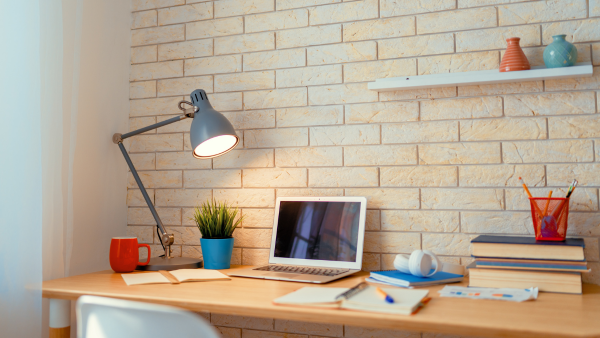
Having a dedicated, productive study space is essential whether you’re a student balancing coursework with other responsibilities or simply trying to learn a new skill. Here are 10 tips to help you create the perfect setup:
1. Choose a Dedicated Space
Find a quiet spot in your home that’s free from distractions. This doesn’t have to be a separate room; it could be a quiet corner of your living space. The key is to select a spot with minimal foot traffic and noise. A dedicated study area will help your brain associate the space with focus and productivity.
2. Ensure Good Lighting
When you have the proper lighting it can reduce eye strain and improve concentration. Try to set up your desk near a window for natural light. If that’s not possible, use a quality desk lamp with adjustable brightness to brighten your workspace.
3. Invest In Comfortable Furniture
Investing in a comfortable chair and a sturdy desk at just the right height is important. Consider choosing an ergonomic chair that supports posture to prevent back or neck pain. Comfort and proper posture go a long way in keeping you focused during long study sessions.
4. Declutter Your Workspace
A tidy desk makes for a more productive desk. Keep only the essentials in your study space to reduce distractions and make your area feel more organized. Consider using organizers, trays, or shelves to store books, supplies, and personal items. A clear workspace can foster a clear headspace.
5. Organize Your Supplies
Searching for supplies can disrupt one’s focus. So, save time and energy by keeping study materials like pens, notebooks, and chargers easily accessible.
6. Minimize Distractions
Identify what pulls your attention away and take steps to eliminate it. Try keeping your phone on silent or in another room unless you need it for studying. Also, use apps like Focus@Will or Freedom to block distracting websites during work sessions.
7. Personalize Your Space
You can make your study area inviting with personal touches like inspirational quotes, artwork, or a small plant. A positive environment can boost motivation.
8. Set Up Tech Tools Efficiency
Set up your tech for seamless productivity. Ensure your computer, internet connection, and other devices are in good working order. Arrange cords and chargers neatly to avoid tangles and keep your desk organized.
9. Control Noise Levels
Noise can be a significant distraction, especially in a busy household. If you’re sensitive to noise, use noise-cancelling headphones or play calming background music. For some, white noise apps can help improve focus.
10. Maintain Healthy Habits
Your study space isn’t just about work; it’s also about maintaining balance. Keep a water bottle nearby to stay hydrated, and take short breaks every hour to stretch or walk around. A balanced approach ensures you stay refreshed and focused.
Creating a productive study space at home doesn’t require a large budget or elaborate setup. With intentional choices and a bit of effort, you can design an environment that enhances your concentration and makes studying more enjoyable. Try implementing these tips to transform your space into a productivity powerhouse.




